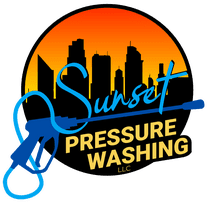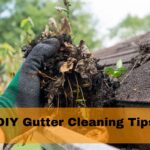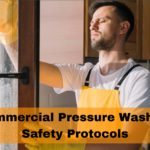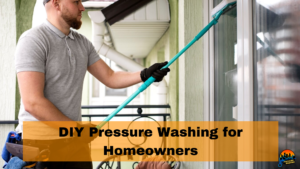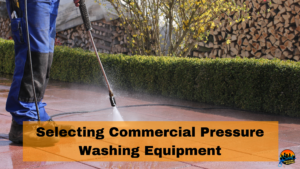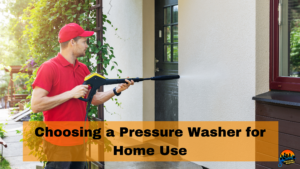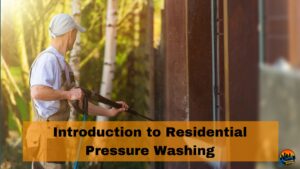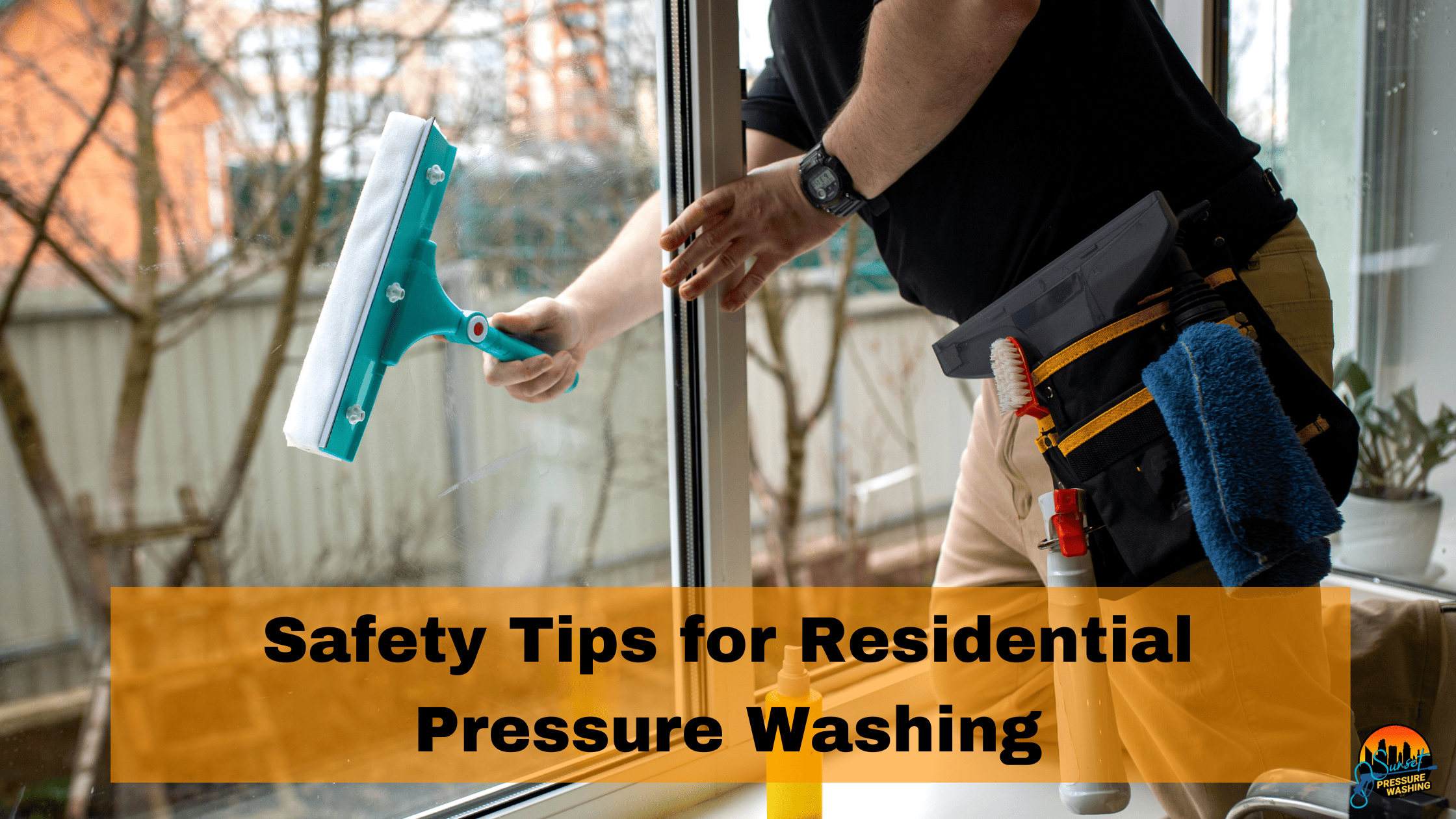
Safety Tips for Residential Pressure Washing
Maintaining the aesthetic and structural integrity of our homes is a task that many homeowners take seriously. Among the arsenal of tools available for this purpose, the pressure washer stands out for its efficiency in removing dirt, grime, and mildew from various surfaces. From driveways and sidewalks to siding and decks, pressure washing can rejuvenate your home’s appearance, potentially increasing its value and curb appeal. However, as powerful and effective as these machines are, they come with their own set of risks and responsibilities. Improper use can lead to damage to your property or, more importantly, injury to yourself or others.
Understanding Your Pressure Washer
Embarking on a residential pressure washing project requires not just the equipment but a deep understanding of it. Pressure washers come in two primary types—electric and gas-powered—each with its unique characteristics, benefits, and considerations. Here, we delve into the critical aspects of understanding your pressure washer, which is the cornerstone for ensuring safety and effectiveness in your cleaning tasks.
Electric vs. Gas-Powered Pressure Washers
Electric pressure washers are known for their convenience and ease of use. They start with a simple push of a button, require less maintenance, and are generally quieter and lighter, making them ideal for light to medium cleaning tasks around the home, such as washing cars, outdoor furniture, and patios.
Gas-powered pressure washers, on the other hand, offer more power and mobility. They are capable of tackling tougher cleaning jobs, like removing stubborn stains from driveways or peeling paint from surfaces, without being tethered by the length of a power cord. However, they require more rigorous maintenance, are louder, and produce emissions, making them less suitable for indoor use.
Key Components and How They Work
Understanding the basic components of your pressure washer is crucial for safe and efficient operation. Here’s a quick overview:
- Pump: The heart of the pressure washer, which pressurizes the water.
- Motor or Engine: Powers the pump; electric models have motors, while gas models have engines.
- Spray Gun and Nozzles: The point of contact for water exiting the machine, with different nozzles offering various spray patterns and pressure intensities suitable for different tasks.
- Hose: Transports the pressurized water from the pump to the spray gun. Its durability and length can impact performance and convenience.
Reading and Understanding the User Manual
Perhaps the most critical step in understanding your pressure washer is to thoroughly read and comprehend the user manual. Manufacturers provide specific instructions on operation, maintenance, and safety precautions tailored to the exact model you have. The manual will detail:
- Assembly instructions.
- Proper start-up and shutdown procedures.
- Recommended settings for various cleaning tasks.
- Maintenance schedules and troubleshooting tips.
- Safety warnings and emergency shut-off procedures.
By familiarizing yourself with the type of pressure washer you have, its components, and the detailed guidance in the user manual, you’re setting a foundation for not just achieving a clean and well-maintained home but also ensuring the safety of yourself and others around you. Always remember, a little preparation and knowledge go a long way in harnessing the full potential of your pressure washer while keeping risks at bay.
Preparing the Area for Pressure Washing
Before you unleash the power of your pressure washer on your home’s exterior, taking the time to properly prepare the area is crucial. This preparation ensures not only the safety of everyone involved but also protects your property from potential damage. Here’s how to effectively prepare your area for pressure washing:
Remove Obstacles and Secure Loose Items
Start by removing any furniture, planters, and decorative items from the area you plan to wash. Not only does this prevent them from getting damaged, but it also gives you unobstructed access to the surfaces you need to clean. Look for items that might be too large to move, such as large outdoor sculptures or fixed benches, and cover them with waterproof tarps to protect them from water damage.
For smaller items, especially those that could become hazardous if moved by the force of the water, secure them in a safe location away from the work area. This includes toys, garden tools, and lightweight outdoor decor that can easily be swept up by the powerful spray.
Protect Delicate Areas and Landscaping
Delicate areas such as windows, doors, and light fixtures need special attention. Waterproof coverings or plastic sheeting can be used to shield these areas from high-pressure water and any cleaning chemicals you might be using. It’s also wise to protect plants and landscaping near your cleaning area. While most established plants will tolerate water well, the pressure and chemicals can cause damage. Use tarps or breathable plant covers to shield them, and consider watering them beforehand to dilute any chemicals that might reach their roots.
Notifying Neighbors and Securing Pets
High-pressure water cleaning can be noisy and may create water spray or mist that travels beyond your immediate area. It’s courteous and practical to notify your neighbors beforehand, so they can take any necessary precautions to protect their property and ensure their pets are indoors. This notification is also essential for maintaining good relationships in your community.
Securing your pets is equally important. The noise and activity can be distressing to animals, and you certainly don’t want them running into the cleaning area. Ensure pets are kept indoors or in a safe area far from the cleaning zone until the job is completed.
By following these preparatory steps, you can ensure a safer and more efficient cleaning process. This preparation not only helps in achieving better cleaning results but also goes a long way in preventing damage and maintaining the harmony of your residential area.
Personal Safety Gear and Precautions
When it comes to residential pressure washing, prioritizing personal safety cannot be overstated. The combination of high-pressure water, cleaning chemicals, and the outdoor environment presents a variety of risks. By equipping yourself with the appropriate safety gear and adhering to safety precautions, you can significantly mitigate these risks. Here’s a comprehensive guide to ensure you’re well-protected during your next pressure washing project.
Essential Safety Gear
- Protective Gloves: High-quality gloves provide a firm grip on the pressure washer handle, reduce vibration discomfort, and protect your hands from chemicals and debris.
- Safety Goggles: Flying debris and chemical splashes are common hazards in pressure washing. Safety goggles form a protective seal around your eyes, shielding them from harm.
- Ear Protection: Long-term exposure to the loud noise generated by pressure washers can harm your hearing. Use earplugs or earmuffs to protect your ears.
- Sturdy Footwear: Slip-resistant, waterproof boots not only keep your feet dry but also protect them from falling objects and sharp debris. They also provide stability on slippery surfaces.
- Appropriate Clothing: Wear long pants and long-sleeved shirts to protect your skin from chemical splashes and flying debris. Choose materials that are durable but comfortable for movement.
Safety Precautions
- Be Aware of Your Surroundings: Before you begin pressure washing, scan the area for potential hazards like electrical lines, slippery surfaces, and bystanders. Keep children and pets inside to avoid accidental injury.
- Use the Equipment Correctly: Familiarize yourself with the pressure washer’s operating instructions. Never point the nozzle at yourself, other people, or pets. Understand how to adjust pressure settings and swap out nozzles safely.
- Maintain a Safe Distance and Angle: Keep the nozzle a safe distance from the surface you’re cleaning to prevent damage to the property or injury to yourself. The angle at which you hold the pressure washer can significantly affect the cleaning efficiency and safety; typically, a 45-degree angle is effective for most surfaces.
- Stay Grounded: When using a ladder or stepping stool, ensure it is stable and secure. It’s easy to underestimate the force of a pressure washer, which can lead to loss of balance.
- Take Breaks: Continuous use of a pressure washer can lead to fatigue, increasing the risk of accidents. Take regular breaks, especially during extensive cleaning projects, to rest and hydrate.
By following these guidelines and properly equipping yourself, you can ensure a safe and effective pressure washing experience. Remember, safety is paramount, not only for the protection of your property but, more importantly, for your well-being and that of those around you.
Safe Operation Techniques for Residential Pressure Washing
Properly operating a pressure washer is crucial to ensure both the safety of the operator and the protection of property. Here are some key techniques and tips to help you use your pressure washer safely and effectively:
Starting and Stopping the Pressure Washer Safely
1. Before Starting:
- Ensure all connections are secure, including the water supply hose, high-pressure hose, and any attachments or nozzles.
- Check the machine for any signs of damage or wear. Do not use it if any unsafe conditions are detected.
- Familiarize yourself with the controls, especially the on/off switch and the pressure adjustment.
2. Starting Procedure:
- Start with the pressure setting on the lowest to avoid sudden kickback.
- Turn on the water supply and let the water flow through the washer for about a minute to remove any air trapped in the hoses.
- Follow the manufacturer’s instructions to start the engine or motor. For gas models, this usually means checking the fuel and oil levels first.
3. Stopping Procedure:
- Release the trigger and let the water stop flowing.
- Turn off the engine or motor.
- Turn off the water supply and disconnect the hoses. Press the trigger to release any remaining pressure before storage.
Adjusting Pressure Settings According to the Surface
- Always start with the lowest pressure setting and gradually increase as needed to avoid damaging the surface being cleaned.
- Use wider angle nozzles (e.g., 15° or greater) for delicate surfaces like wood decks or painted items to disperse the pressure over a larger area.
- Reserve high pressure settings and narrower angle nozzles for more resilient surfaces like concrete or metal.
Keeping a Safe Distance and Using the Correct Angle
Distance:
- Maintain a safe distance from the surface to prevent damage. A good rule of thumb is to start with the nozzle about two feet away and adjust as needed.
- Closer distances increase the cleaning power but also the risk of damage, so approach closer gradually.
Angle:
- Angle the spray at a slight angle to lift and remove dirt more effectively. Spraying directly at a flat surface can push dirt deeper into the material.
- For cleaning walls, an upward angle may help in lifting dirt, while a downward angle is safer for roofing to prevent water from getting underneath the shingles.
Additional Safety Tips
- Never point the pressure washer at people, pets, or delicate objects.
- Be mindful of the kickback when the pressure washer is first turned on. Firmly grip the handle to control it.
- Avoid using ladders if possible. The recoil from the spray gun can lead to falls. Use extensions or telescoping wands for high areas instead.
- Be aware of slippery surfaces, both from the water and the cleaning solutions.
By following these safe operation techniques, you can ensure a safe and effective cleaning process, preserving the integrity of your property and protecting yourself and others from harm.
Chemical Use and Safety in Residential Pressure Washing
When using a pressure washer for residential cleaning tasks, it’s not uncommon to incorporate chemicals or cleaning solutions to achieve more effective results. However, the use of these substances requires careful handling and awareness to ensure both personal safety and environmental protection. Here are key considerations and best practices for chemical use in pressure washing:
1. Choosing the Right Cleaning Solutions
- Environmentally Friendly Options: Opt for biodegradable and eco-friendly cleaning solutions that minimize harm to your garden, pets, and the local ecosystem. These solutions can effectively remove dirt and mildew without the harsh side effects of stronger chemicals.
- Surface-Specific Cleaners: Use chemicals that are specifically designed for the surfaces you’re cleaning, such as concrete, wood, or vinyl siding. This ensures the cleaning process is effective without damaging the material.
2. Safe Handling of Chemicals
- Personal Protective Equipment (PPE): Always wear gloves and goggles when handling chemical cleaners to prevent skin irritation and protect your eyes from splashes.
- Proper Ventilation: When mixing or using chemicals, ensure you are in a well-ventilated area to avoid inhaling fumes, which can be harmful.
- Correct Mixing: Follow the manufacturer’s instructions for diluting concentrated solutions. Incorrect mixing can not only be less effective but also dangerous.
3. Application and Use
- Pre-Soak Surfaces: For tough grime, pre-soaking the surface with a diluted cleaning solution can help break down the dirt before pressure washing.
- Appropriate Pressure Settings: Use a lower pressure setting when applying cleaning solutions to avoid splattering and ensure the chemical has time to work on the surface.
- Rinsing: Thoroughly rinse the cleaned surface with plain water to remove any residual chemicals, protecting both the surface and the surrounding landscape.
4. Storage and Disposal
- Secure Storage: Keep chemicals in their original containers with labels intact, and store them out of reach of children and pets.
- Proper Disposal: Dispose of unused chemicals and containers according to local regulations. Never pour them down the drain, into the ground, or into waterways, as they can contaminate water sources and harm aquatic life.
5. Environmental Considerations
- Water Runoff: Be mindful of where chemical-laden water is running off. Avoid allowing it to enter storm drains or areas where it can negatively impact the environment.
- Minimize Use: Whenever possible, use the least amount of chemical needed to achieve your cleaning goals. Often, a smaller amount than recommended can be effective, reducing environmental impact.
Dealing with Electrical and Water Safety
When it comes to residential pressure washing, the combination of water and electricity necessitates extra caution. Ensuring your safety from electrical hazards while using a high-powered water device is paramount. Here are critical guidelines to follow to avoid accidents and damage.
Avoid Electrical Hazards
Equip your hose with a nozzle that allows you to control the water pressure. Start with a moderate flow to avoid damaging the gutters. First and foremost, be conscious of all electrical elements around your washing area. This includes outdoor outlets, power lines, and any electrical devices. Water is a conductor for electricity, and even a small mistake can lead to serious accidents. Before you begin pressure washing, make sure to cover or seal off outdoor outlets and electrical boxes with waterproof covers. Additionally, be mindful of the power cord of the pressure washer itself. Keep it away from the path of water and ensure that it is connected to a power source through a Ground Fault Circuit Interrupter (GFCI) outlet.
Use GFCI Outlets
A Ground Fault Circuit Interrupter (GFCI) outlet is designed to protect you from electrical shock by shutting off the electrical circuit when it detects that the electricity is flowing along an unintended path, such as through water or a person. Always plug your pressure washer into a GFCI outlet. If your outdoor areas are not equipped with these, consider having them installed or use a portable GFCI adapter which can be plugged into a standard outlet. This small step can significantly reduce the risk of electrocution.
Ensure Proper Insulation and Distance
Your pressure washer’s power cord and any extension cords used should be properly insulated and rated for outdoor use. Check for any wear or damage before use, and replace damaged cords immediately. Additionally, maintain a safe distance from the power source and the area being washed. This helps prevent water from splashing onto electrical components or the electrical connections themselves.
Water Safety Measures
Beyond electrical safety, managing water flow and pressure is also critical. Make sure water does not accumulate near electrical devices or outlets. Use a pressure washer with an automatic shut-off feature to prevent it from running unattended, which can lead to unintended water flow towards electrical hazards.
Routine Checks and Safety Practices
Before each use, perform a quick safety check of your equipment, electrical cords, and the environment. Look for potential hazards and address them before starting. Always follow the manufacturer’s instructions for both your pressure washer and any electrical safety devices you employ. Awareness and preparation are your best defenses against accidents.
By adhering to these safety measures, you can significantly mitigate the risks associated with mixing electricity and water during pressure washing tasks. These precautions not only ensure your safety but also protect your property from potential damage. Always prioritize safety over convenience, and do not hesitate to consult a professional if you encounter any electrical safety concerns.
Ensure that the water exiting the downspouts is draining properly away from your home’s foundation. Poor drainage can lead to foundation issues.
Maintenance and Storage of Your Pressure Washer
Proper maintenance and storage of your pressure washer are crucial for extending its lifespan and ensuring it operates safely and efficiently. Neglecting these aspects can lead to malfunctions, safety hazards, or the need for costly repairs. Follow these guidelines to keep your pressure washer in top condition.
Regular Maintenance Checks
- Inspect Hoses and Connections: Before and after each use, check the hoses for any signs of wear, leaks, or cracks. Ensure all connections are tight and secure to prevent any sudden disconnections or water leaks.
- Clean the Nozzles: Clogged nozzles can drastically reduce the efficiency of your pressure washer and even cause it to malfunction. Use a pin or a specialized nozzle-cleaning tool to clear any debris. Flush them with water to ensure they are clean.
- Check the Water Inlet Filter: This filter prevents debris from entering the pressure washer through the water supply. Clean it regularly to ensure smooth water flow and protect the internal components of your pressure washer.
- Engine and Pump Maintenance: For gas-powered models, check the engine oil level before each use and change the oil as recommended by the manufacturer. For all types, lubricate the pump as specified in the user manual to keep it running smoothly.
- Winterization: If you live in an area where freezing temperatures are common, it’s essential to winterize your pressure washer to prevent water from freezing inside it, which can cause damage. Use antifreeze in the pump or store the unit in a frost-free environment.
Proper Storage Practices
- Drain Water Completely: After each use, ensure all water is drained from the pressure washer to prevent internal corrosion and damage. This is especially important before storing the unit for an extended period.
- Store in a Dry, Ventilated Area: Moisture can cause corrosion and other issues, so it’s important to store your pressure washer in a dry, well-ventilated area. Avoid places with extreme temperature changes to prevent damage to the components.
- Protect from Dust and Dirt: Cover your pressure washer with a breathable cover to protect it from dust, dirt, and other contaminants that could clog or corrode its parts.
- Coil Hoses Properly: Avoid kinks and wear in hoses by coiling them loosely and hanging them or laying them flat for storage. This prevents the hoses from becoming damaged and extends their lifespan.
- Follow Manufacturer’s Instructions for Long-Term Storage: For extended periods of non-use, refer to your pressure washer’s manual for specific long-term storage instructions. This may include steps like lubricating certain parts, using fuel stabilizer in gas models, and other specific guidelines to ensure your machine starts up smoothly when you next need to use it.
By adhering to these maintenance and storage practices, you can ensure your pressure washer remains a reliable and effective tool for keeping your home’s exterior clean. Regular upkeep not only safeguards your investment but also reinforces safety during use, providing peace of mind as you maintain your property.
Ensuring a Safe and Effective Pressure Washing Experience
Sunset Pressure Washing is an invaluable tool for maintaining the aesthetic and structural integrity of your residential property. However, the power of a pressure washer, combined with the complexities of operating it, introduces a range of safety concerns that must not be overlooked. By understanding your equipment, preparing your work area, donning appropriate safety gear, adhering to safe operation techniques, handling chemicals cautiously, being mindful of electrical and water safety, and maintaining your equipment properly, you can mitigate risks and ensure a safe cleaning process.
Remember, the key to effective and efficient pressure washing lies not just in the removal of dirt and grime, but in doing so safely and sustainably. We encourage homeowners to approach Sunset Pressure Washing services with the seriousness it deserves, prioritizing safety above all. Whether you’re a novice or have years of experience, revisiting these safety tips can help prevent accidents and damage to your property.
